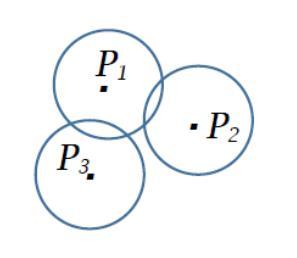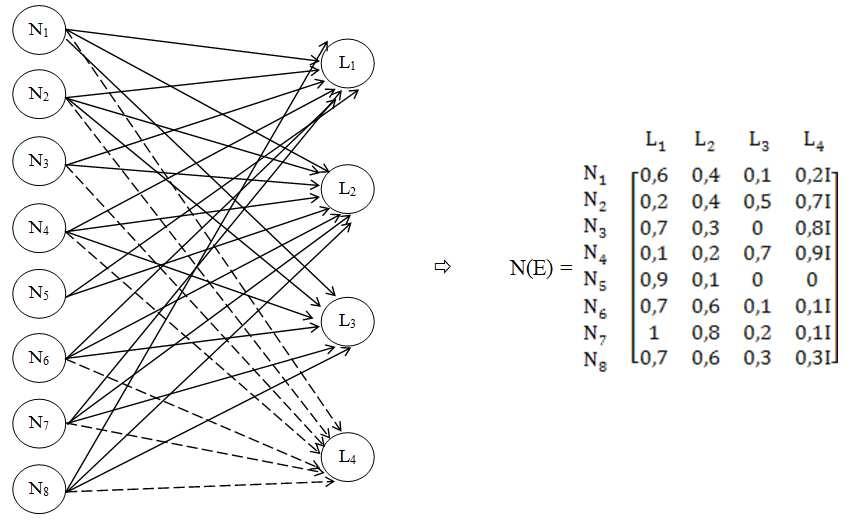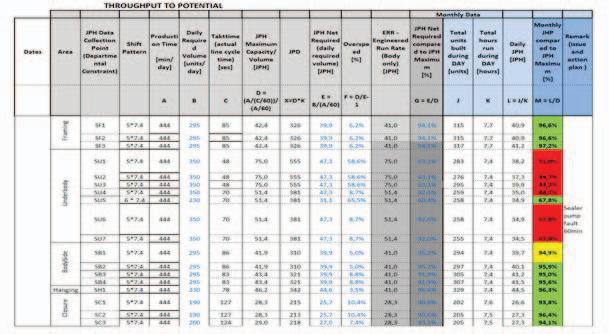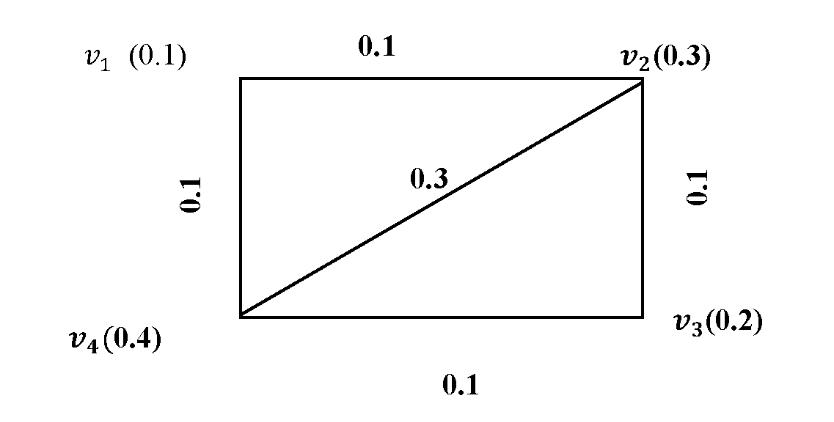
32 minute read
Operations on Interval Valued Neutrosophic Graphs
Said Broumi, Florentin Smarandache, M. Talea, A. Bakali (2016). Operations on Interval Valued Neutrosophic Graphs. New Trends in Neutrosophic Theory and Applications I: 231-254
Advertisement
Abstract
Combining the single valued neutrosophic set with graph theory, a new graph model emerges, called single valued neutrosophic graph. This model allows attaching the truth-membership (t), indeterminacy–membership (i) and falsity- membership degrees (f) both to vertices and edges. Combining the interval valued neutrosophic set with graph theory, a new graph model emerges, called interval valued neutrosophic graph. This model generalizes the fuzzy graph, intuitionistic fuzzy graph and single valued neutrosophic graph. In this paper, the authors define operations of Cartesian product, composition, union and join on interval valued neutrosophic graphs, and investigate some of their properties, with proofs and examples. Keywords
Neutrosophy, neutrosophic set, fuzzy set, fuzzy graph, neutrosophic graph, interval valued neutrosophic set, single valued neutrosophic graph, interval valued neutrosophic graph.
1. Introduction
The neutrosophy was pioneered by F. Smarandache (1995, 1998). It is a branch of philosophy which studies the origin, nature, and scope of neutralities, as well as their interactions with different ideational spectra. The neutrosophic set proposed by Smarandache is a powerful tool to deal with incomplete, indeterminate and inconsistent information in real world, being a generalization of fuzzy set ( Zadeh 1965; Zimmermann 1985), intuitionistic fuzzy set (Atanassov 1986; Atanassov 1999),interval valued fuzzy set (Turksen 1986) and interval valued intuitionistic fuzzy sets (Atanassov and Gargov 1989).The neutrosophic set is characterized by a truth-membership degree (t), an indeterminacy-membership degree (i) and a falsity-membership degree (f) independently, which are within the real standard or nonstandard unit interval ]−0, 1+[. If the range is restrained within the real standard unit interval [0, 1], the neutrosophic set easily applies to engineering problems. For this purpose, Wang et al. (2010) introduced the concept of single valued neutrosophic set (SVNS) as a subclass of the neutrosophic set. The same author introduced the notion of interval valued neutrosophic sets (Wang et al. 2005b, 2010) as subclass of neutrosophic sets in which the value of truth-membership, indeterminacy-membership and falsity-membership
degrees are intervals of numbers instead of real numbers. The single valued neutrosophic set and the interval valued neutrosophic set have been applied in a wide variety of fields, including computer science, engineering, mathematics, medicine and economics (Ansari 2013a, 2013b, 2013c;Aggarwal 2010;Broumi 2014;Deli 2015;Hai-Long 2015;Liu and Shi 2015;Şahin 2015; Wang et al. 2005b;Ye 2014a, 2014b,2014c).
Graph theory has now become a major branch of applied mathematics and it is generally regarded as a branch of combinatorics. Graph is a widely used tool for solving combinatorial problems in different areas, such as geometry, algebra, number theory, topology, optimization and computer science. To be noted that, when there is uncertainty regarding either the set of vertices or edges, or both, the model becomes a fuzzy graph. Many works on fuzzy graphs, intuitionistic fuzzy graphs and interval valued intuitionistic fuzzy graphs (Antonios K et al. 2014; Bhattacharya 1987; Mishra and Pal 2013; Nagoor Gani and Shajitha Begum 2010; Nagoor Gani and Latha 2012; Nagoor Gani and Basheer Ahamed 2003;Parvathi and Karunambigai 2006; Shannon and Atanassov 1994) have been carried out and all of them have considered the vertex sets and edge sets as fuzzy and /or intuitionistic fuzzy sets. But, when the relations between nodes (or vertices) are indeterminate, the fuzzy graphs and intuitionistic fuzzy graphs fail to work. For this purpose, Smarandache (2015a, 2015b, 2015c) defined four main categories of neutrosophic graphs. Two are based on literal indeterminacy (I): I-edge neutrosophic graph and I-vertex neutrosophic graph. The two categories were deeply studied and gained popularity among the researchers (Garg et al. 2015,Vasantha Kandasamy2004, 2013, 2015) due to their applications via real world problems. The other neutrosophic graph categories are based on (t, i, f) components and are called:(t, i, f)-edge neutrosophic graph and (t, i, f)-vertex neutrosophic graph. These two categories are not developed at all.
Further on, Broumi et al. (2016b) introduced a new neutrosophic graph model, called single valued neutrosophic graph (SVNG), and investigated some of its properties as well. This model allows attaching the membership (t), indeterminacy (i) and non-membership degrees (f) both to vertices and edges. The single valued neutrosophic graph is a generalization of fuzzy graph and intuitionistic fuzzy graph. Broumi et al. (2016a) also introduced neighborhood degree of a vertex and closed neighborhood degree of a vertex in single valued neutrosophic graph, as a generalization of neighborhood degree of a vertex and closed neighborhood degree of a vertex in fuzzy graph and intuitionistic fuzzy graph. Moreover, Broumi et al. (2016c) introduced the concept of interval valued neutrosophic graph, as a generalization of single valued neutrosophic graph, and discussed some properties, with proofs and examples. In addition, Broumi et al.(2016c) introduced the concept of bipolar single valued neutrosophic graph, as a generalization of fuzzy graphs, intuitionistic fuzzy graph, N-graph, bipolar fuzzy graph and single valued neutrosophic graph, and studied some related properties.
In this paper, researchers’ objective is to define some operations on interval valued neutrosophic graphs, and to investigate some properties.
2. Preliminaries
In this section, the authors mainly recall some notions related to neutrosophic sets, single valued neutrosophic sets, interval valued neutrosophic sets, fuzzy graphs, intuitionistic fuzzy graphs, interval valued intuitionistic fuzzy graphs, single valued neutrosophic graphs and interval valued neutrosophic graphs, relevant to the present work. The readers are referred for further details to (Broumi et al. 2016b;Mishra and Pal 2013;Nagoor Gani and Basheer Ahamed 2003;Parvathi and Karunambigai 2006;Smarandache 2006;Wang et al. 2010;Wang et al. 2005a). Definition 1 (Smarandache 2006)
Let X be a space of points (objects) with generic elements in X denoted by x; then the neutrosophic set A (NS A) is an object having the form A = {< x: TA(x), IA(x), FA(x)>, x ∈X}, where the functions T, I, F: X→]−0,1+[ define respectively a truth-membership function, an indeterminacy-membership function, and a falsity-membership function of the element x ∈X to the set A with the condition: −0 ≤ TA(x)+ IA(x)+ FA(x)≤ 3+ . (1)
The functions TA(x), IA(x) and FA(x) are real standard or nonstandard subsets of ]−0,1+[.
Since it is difficult to apply NSs to practical problems, Wang et al. 2010 introduced the concept of a SVNS, which is an instance of a NS and can be used in real scientific and engineering applications. Definition 2 (Wang et al. 2010)
Let X be a space of points (objects) with generic elements in X denoted by x. A single valued neutrosophic set A (SVNS A) is characterized by truth-membership function TA(x) , an indeterminacy-membership function IA(x), and a falsity-membership function FA(x). For each point x in X, TA(x), IA(x), FA(x)∈ [0, 1]. A SVNS A can be written as A = {< x: TA(x), IA(x), FA(x)>, x ∈ X} (2) Definition 3 (Wang et al. 2005a)
Let X be a space of points (objects) with generic elements in X denoted by x. An interval valued neutrosophic set (for short IVNS A) A in X is characterized by truth-membership function TA(x), indeteminacy-membership function IA(x) and falsity-membership function FA(x). For each point x in X, one has that
TA(x) = [������(x), ������(x)],
IA(x) = [������(��), ������(��)],
FA(x) = [������(��), ������(��)] ⊆[0, 1], and 0 ≤ TA(x)+ IA(x)+ FA(x)≤ 3. (3)
Definition 4 (Wang et al. 2005a)
An IVNS A is contained in the IVNS B, A ⊆ B, if and only if ������(x) ≤ ������(x), ������(x) ≤ ������(x), ������(x) ≥ ������(x), ������(x) ≥ ������(x), ������(x) ≥ ������(x), ������(x) ≥ ������(x), for any x in X. (4) Definition 5 (Wang et al. 2005a) The union of two interval valued neutrosophic sets A and B is an interval neutrosophic set C, written as C = A ∪ B, whose truth-membership, indeterminacy-membership, and false membership are related to those A and B by ������(x) = max (������(x), ������(x)) ������(x) = max (������(x), ������(x))
������(x) = min (������(x), ������(x))
������(x) = min (������(x), ������(x)), for all x in X. (5) Definition 6 (Wang et al 2005a) Let X and Y be two non-empty crisp sets. An interval valued neutrosophic relation R(X, Y) is a subset of product space X × Y, and is characterized by the truth membership function ����(x, y), the indeterminacy membership function IR(x, y), and the falsity membership function ����(x, y), where x ∈ X and y ∈ Y and ����(x, y),IR(x, y),����(x, y) ⊆ [0, 1].
Definition 7 (Nagoor Gani and Basheer Ahamed 2003) A fuzzy graph is a pair of functions G = (σ, µ), where σ is a fuzzy subset of a non-empty set V and μ is a symmetric fuzzy relation on σ, i.e.σ: V → [ 0,1] and μ: VxV→[0,1], such that μ(uv) ≤ σ(u) ⋀σ(v), for all u, v ∈ V where uv denotes the edge between u and v and σ(u) ⋀σ(v) denotes the minimum of σ(u) and σ(v). σ is called the fuzzy vertex set of G andμ is called the fuzzy edge set of G.
Figure 1: Fuzzy Graph
Definition 8 (Nagoor Gani and Basheer Ahamed 2003) The fuzzy subgraph H=(τ,ρ) is called a fuzzy subgraph of G =( σ, µ) if τ(u) ≤ σ(u) for all u ∈ V and ρ(u, v) ≤ μ(u, v) for all u, v ∈ V. Definition 9 (Parvathi and Karunambigai 2006)
An Intuitionistic fuzzy graph is of the form G=<V,E>,where V={v1,v2,….,vn},such that ��1:V→ [0,1] and ��1:V→ [0,1] denote the degree of membership and non-membership of the elementvi ∈ V, respectively, and 0≤ ��1(vi)+��1(vi))≤ 1,forevery vi ∈ V,(i=1, 2,……. n), (6)
E ⊆ VxVwhere ��2:VxV→[0,1]and ��2:VxV→ [0,1] are such that ��2(vi,vj)≤ min[��1(vi),��1(vj)] and ��2(vi,vj)≥ max[��1(vi),��1(vj)], and
0≤��2(vi,vj)+��2(vi,vj)≤1 for every (vi,vj) ∈E,(i,j =1,2,……. n)(7)
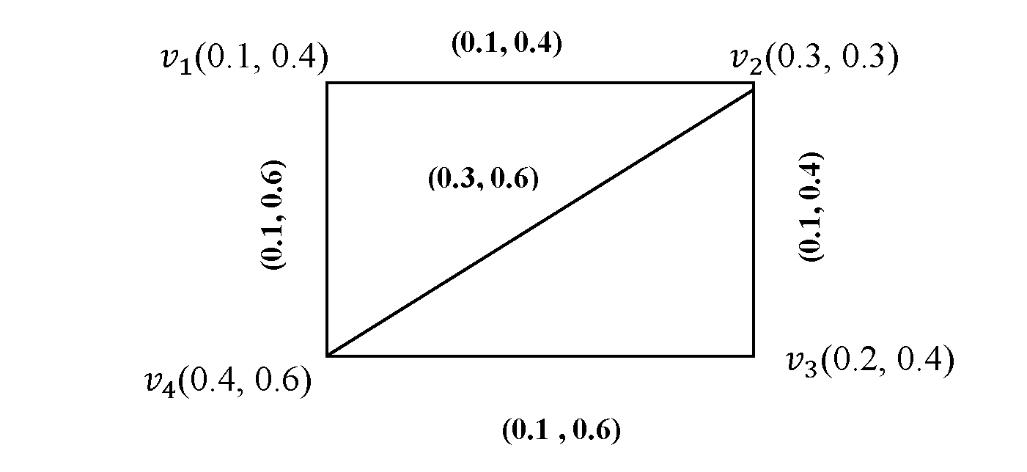
Figure 2: Intuitionistic Fuzzy Graph
Definition 10 (Mishra and Pal 2013)
An interval valued intuitionistic fuzzy graph (IVIFG) G= (A, B) satisfies the following conditions: 1.V= {��1 ,��2 ,… ,����} such that ������:V→[0, 1],������:V→[0, 1] and ������:V→[0,1], ������:V→[0, 1] denote the degree of membership and non-membership of the element ��∈ V, respectively, and 0≤����(��) +����(��)≤1 for every �� ∈ V (8) 2.The functions ������:V x V →[0, 1],������:V x V →[0, 1] and ������:V x V →[0,1], ������:V x V →[0, 1] are denoted by ������(����)≤ min [������(��), ������(��)], ������(����)≤ min [������(��), ������(��)] ������(����)≥ max [������(��), ������(��)] , ������(����)≥ max[������(��), ������(��)] such that 0≤����(����) + ����(����)≤1, for every ���� ∈ E (9)
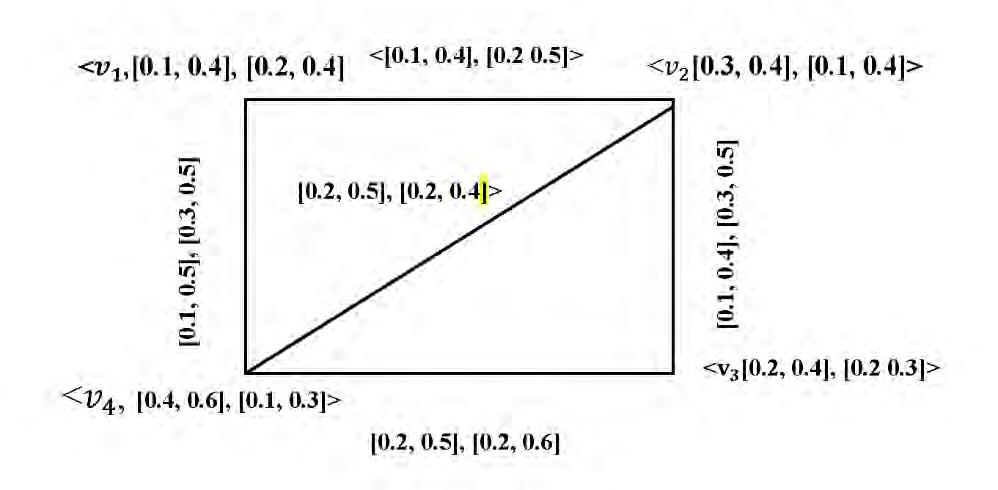
Figure 3: Interval valued intuitionistic graph
Definition 11 (Broumi et al. 2016b)
A single valued neutrosophic graph (SVN-graph) with underlying set V is defined to be a pair G= (A, B), where: 1.The functions ����:V→[0, 1], ����:V→[0, 1] and ����:V→[0, 1] denote the degree of truthmembership, degree of indeterminacy-membership and falsity-membership of the element ���� ∈ V, respectively, and 0≤����(����) + ����(����) +����(����)≤3, for all ���� ∈ V (i=1, 2, …,n) (10) 2. The functions ����: E ⊆ V x V →[0, 1],����: E ⊆ V x V →[0, 1] and ����: E ⊆ V x V →[0, 1] are defined by
(11) and denote the degree of truth-membership, indeterminacy-membership and falsitymembership of the edge (����,����) ∈ E respectively, where 0≤����({����,����}) + ����({����,����})+ ����({����,����})≤3, for all {����,����}∈ E (i, j = 1, 2,…, n). (12)
“A”is called the single valued neutrosophic vertex set of V, “B” -the single valued neutrosophic edge set of E, respectively. B is a symmetric single valued neutrosophic relation on A. The notation (����,����)is used for an element of E. Thus, G = (A, B) is a single valued neutrosophic graph of G∗ = (V, E), if :
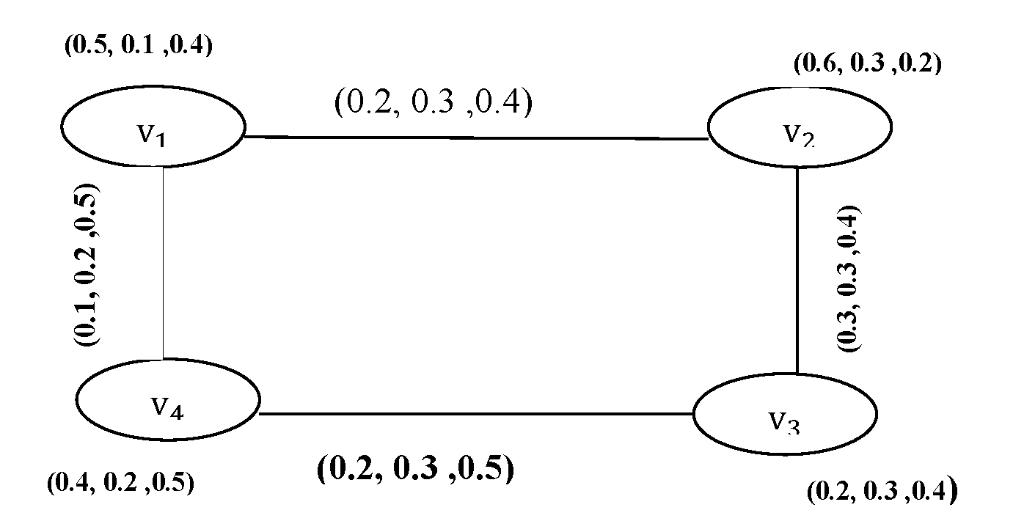
Figure 4: Single valued neutrosophic graph
(13)
Definition 12 (Broumi et al. 2016b)
Let G = (A, B) be a single valued neutrosophic graph. Then the degree of a vertex v is defined by d(v)= (����(��), ����(��),����(��)), where ����(��)=∑��≠������(��,��), ����(��)=∑��≠������(��,��) and ����(��)=∑��≠������(��,��) (14)
Definition 13 (Broumi et al. 2016b)
A single valued neutrosophic graph G= (A, B) and ��∗ is called strong neutrosophic graph ����(����,����)= min [����(����), ����(����)] ����(����,����)= max [����(����), ����(����)] ����(����,����)= max [����(����), ����(����)] for all (����,����)∈ E. Definition 14 (Broumi et al. 2016b) (15)
The complement of a strong single valued neutrosophic graph G on ��∗ is strong single valued neutrosophic graph �� on ��∗ where 1.�� ̅ =V 2.���� ̅̅̅ (����)= ����(����),���� ̅ (����)= ����(����),���� ̅̅̅ (����)= ����(����), ���� ∈ V. 3.���� ̅̅̅ (����,����)= min[����(����),����(����)]-����(����,����) ���� ̅ (����,����)= max[����(����),����(����)]-����(����,����) and ���� ̅̅̅ (����,����)= max[����(����),����(����)]-����(����,����), for all (����,����)∈ E. (16) Definition 15 (Broumi et al. 2016b)
A single valued neutrosophic graph G = (A, B) is called complete, if: ����(����,����)= min(����(����), ����(����)), ����(����,����)= max(����(����), ����(����)) and ����(����,����)= max(����(����), ����(����)), for every ����,���� ∈ V. (17)
Example 1
Consider a graph ��∗= (V, E) such that V = {a, b, c, d} , E= {ab ,ac ,bc , cd}. Then, G= (A, B) is a single valued neutrosophic complete graph of ��∗ .
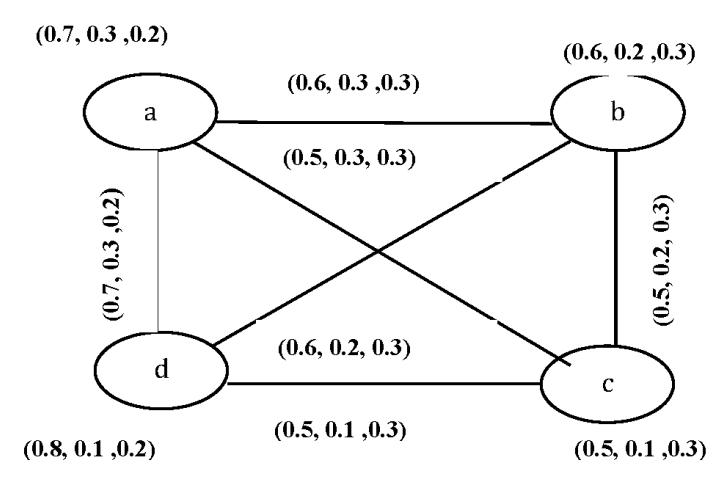
Throughout this section, G∗ = (V, E) denotes a crisp graph, and G -an interval valued neutrosophic graph. Definition 16
By an interval-valued neutrosophic graph of a graph ��∗=(V,E)one means a pair G=(A,B), where A=< [������, ������], [������, ������], [������, ������]>is an interval-valued neutrosophic set on V and B=< [������, ������], [������, ������], [������, ������] > is an interval-valued neutrosophic relation on E satisfying the following condition: 1.V= {��1,��2 ,…,����} such that ������:V→[0, 1],������:V→[0, 1], ������:V→[0,1],������:V→[0, 1] and ������:V→[0,1], ������:V→[0, 1] denote the degree of truth-membership, the degree of indeterminacymembership and falsity-membership of the element ��∈ V, respectively, and 0≤����(����)+ ����(����) +����(����)≤3, for every���� ∈ V. (18) 2. The functions ������:V x V →[0, 1],������:V x V →[0, 1],������:V x V →[0, 1],������:V x V →[0, 1] and ������:V x V →[0,1], ������:V x V →[0, 1], such that
������(����,����)≥ max [������(����), ������(����)] ������(����,����)≥ max [������(����), ������(����)] (19) denote the degree of truth-membership, indeterminacy-membership and falsity-membership of the edge (����,����) ∈ E respectively, where 0≤����(����,����) + ����(����,����)+ ����(����,����)≤3, for all (����,����)∈ E. Example 2
Figure 5 is an example for IVNG, G = (A,B) defined on a graph ��∗= (V, E) such that V = {x, y, z}, E = {xy, yz, zx}, A is an interval valued neutrosophic set of V
(20)
A={ < x, [0.5, 0.7], [0.2, 0.3], [0.1, 0.3]>, <y, [0.6, 0.7],[0.2, 0.4], [0.1, 0.3]>, <z, [0.4, 0.6],[0.1, 0.3], [0.2, 0.4],>}, and B an interval valued neutrosophic set of E⊆V x V
B={ <xy, [0.3, 0.6], [0.2, 0.4], [0.2, 0.4]>, <yz, [0.3, 0.5],[0.2, 0.5], [0.2, 0.4]>, <xz, [0.3, 0.5],[0.3, 0.5], [0.2, 0.4]>}.
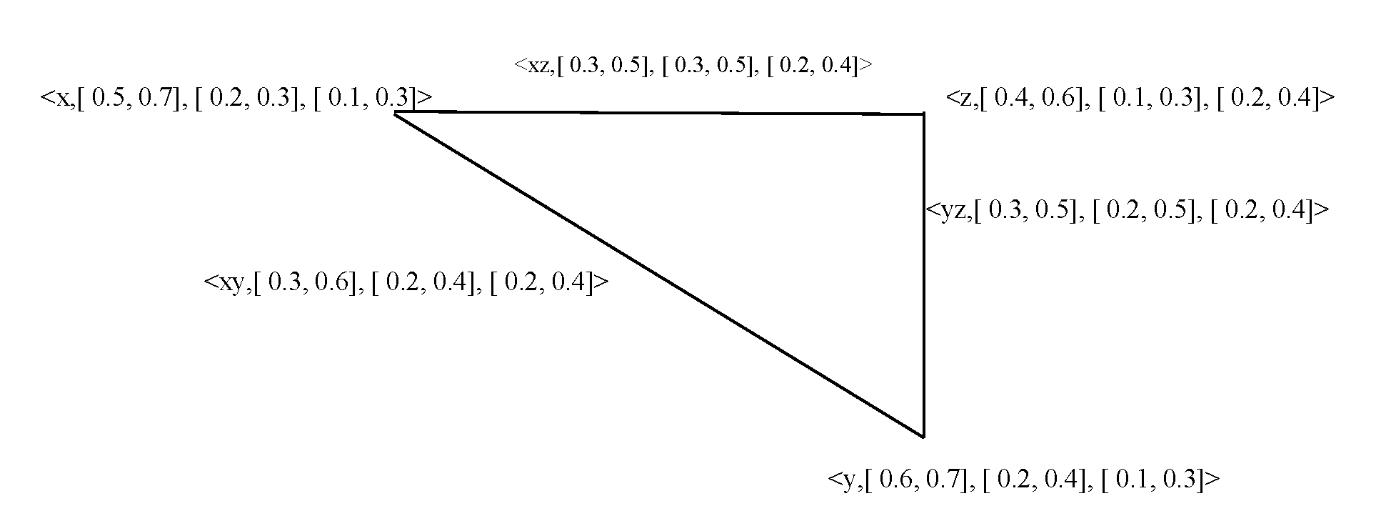
Figure 6: Interval valued neutrosophic graph
Here, the new concept of Cartesian product is given. Definition 17
Let ��∗ = ��1 ∗×��2 ∗=(V, E) be the Cartesian product of two graphs where V = ��1×��2and E= {(��, ��2) (��, ��2) /�� ∈��1, ��2��2 ∈��2} ∪{(��1, ��) (��1, ��) /�� ∈��2, ��1��1 ∈��1}; then, the Cartesian product G = ��1×��2 = ( ��1×��2, ��1×��2 ) is an interval valued neutrosophic graph defined by 1) (����1��×����2��) (��1,��2) = min (����1��(��1), ����2��(��2)) (����1��×����2��) (��1,��2) = min (����1��(��1), ����2��(��2)) (����1��×����2��) (��1,��2) = max (����1��(��1), ����2��(��2)) (����1��×����2��) (��1,��2) = max (����1��(��1), ����2��(��2)) (����1��×����2��) (��1,��2) = max (����1��(��1), ����2��(��2)) (����1��×����2��) (��1,��2) = max (����1��(��1), ����2��(��2)) for all ( ��1,��2) ∈��. (21) 2) (����1��×����2��) ((��,��2)(��,��2)) = min (����1��(��), ����2��(��2��2)) (����1��×����2��) ((��,��2)(��,��2)) = min (����1��(��), ����2��(��2��2)) (����1��×����2��) ((��,��2)(��,��2)) = max (����1��(��), ����2��(��2��2)) (����1��×����2��) ((��,��2)(��,��2)) = max (����1��(��), ����2��(��2��2)) (����1��×����2��) ((��,��2) (��,��2)) = max (����1��(��), ����2��(��2��2))
3) (����1��×����2��) ((��1,��) (��1,��)) = min (����1��(��1��1), ����2��(��)) (����1��×����2��) ((��1,��) (��1,��)) = min (����1��(��1��1), ����2��(��)) (����1��×����2��) ((��1 ,��) (��1,��)) = max (����1��(��1��1), ����2��(��)) (����1��×����2��) ((��1 ,��) (��1,��)) = max (����1��(��1��1), ����2��(��)) (����1��×����2��) ((��1 ,��) (��1,��)) = max (����1��(��1��1), ����2��(��)) (����1��×����2��) ((��1 ,��) (��1,��)) = max (����1��(��1��1), ����2��(��)) ∀ z ∈��2, ∀��1��1 ∈��1. (23)
Example 3
Let ��1 ∗= (��1, ��1) and ��2 ∗= (��2, ��2) be two graphs where��1 ={a, b}, ��2 ={c, d},��1 ={a, b} and ��2 ={c, d}.Consider two interval valued neutrosophic graphs: ��1={ <a, [0.5, 0.7], [0.2, 0.3], [0.1, 0.3]>, <b, [0.6, 0.7],[0.2, 0.4], [0.1, 0.3]>}, ��1={ <ab, [0.3, 0.6], [0.2, 0.4], [0.2, 0.4]>}; ��2={ <c, [0.4, 0.6], [0.2, 0.3], [0.1, 0.3]>, <d, [0.4, 0.7],[0.2, 0.4], [0.1, 0.3}>}, ��2={ <cd, [0.3, 0.5], [0.4, 0.5], [0.3, 0.5]>}.

Figure 7: Interval valued neutrosophic graph G1
Figure 8: Interval valued neutrosophic graph G2

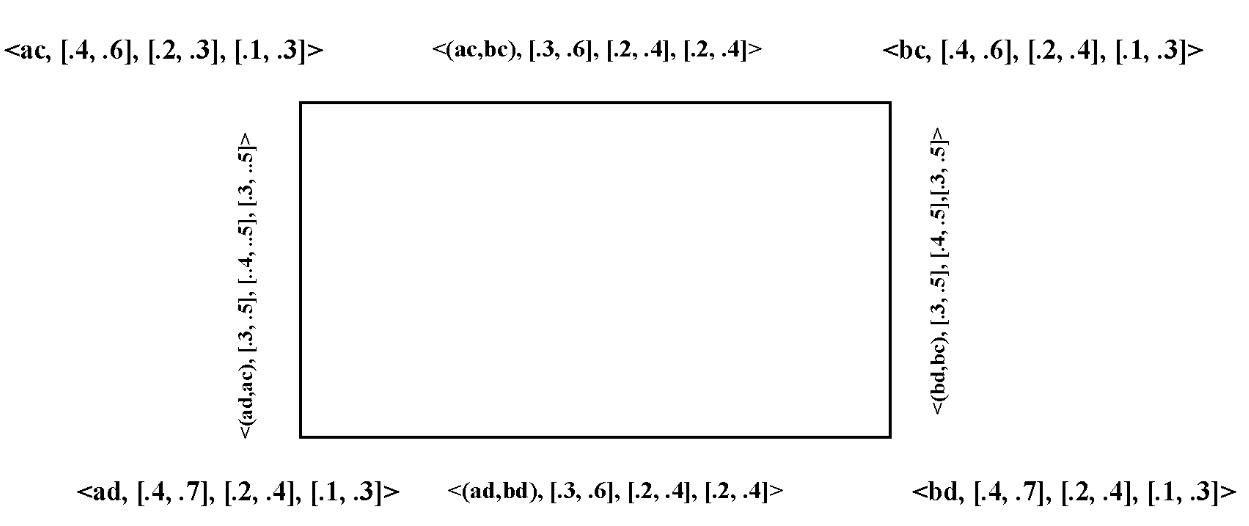
By routine computations, It is easy to see that G1×G2 is an interval-valued neutrosophic graph of ��1 ∗×��2 ∗ . Proposition 1 The Cartesian product G1×G2=( ��1×��2, ��1×��2 ) of two interval valued neutrosophic graphs of the graphs ��1 ∗and��2 ∗ is an interval valued neutrosophic graph of ��1 ∗×��2 ∗ . Proof. Verifying only conditions for B1×B2, because conditions for A1×A2 areobvious. Let E= {(��,��2) (��,��2) /�� ∈��1,��2��2 ∈��2} ∪{(��1, ��) (��1, ��) /�� ∈��2,��1��1 ∈��1}
Considering (��,��2) (��,��2) ∈��, one has: (����1��×����2��) ((��,��2) (��,��2)) = min (����1��(��), ����2��(��2��2))≤ min (����1��(��), min(����2��(��2),����2��(��2))) = min(min (����1��(��),����2��(��2)), min (����1��(��),����2��(��2))) = min ((����1��×����2��) (��,��2),(����1��×����2��) (��,��2)), (24) (����1��×����2��) ((��,��2) (��,��2)) = min (����1��(��), ����2��(��2��2)) ≤ min (����1��(��), min(����2��(��2),����2��(��2)))= min(min (����1��(��),����2��(��2)),min ����1��(��),����2��(��2)))= min ((����1��×����2��) (��,��2),(����1��×����2��) (��,��2)), (25) (����1��×����2��) ((��,��2) (��,��2)) = max (����1��(��), ����2��(��2��2)) ≥ max (����1��(��), max(����2��(��2),����2��(��2))) = max(max (����1��(��),����2��(��2)), max (����1��(��),����2��(��2))) = max ((����1��×����2��) (��,��2),(����1��×����2��) (��,��2)), (26) (����1��×����2��) ((��,��2) (��,��2)) = max (����1��(��), ����2��(��2��2)) ≥ max (����1��(��), max(����2��(��2),����2��(��2)))= max(max (����1��(��),����2��(��2)), max (����1��(��),����2��(��2))) = max ((����1��×����2��) (��,��2),(����1��×����2��) (��,��2)), (27)
(����1��×����2��) ((��,��2) (��,��2)) = max (����1��(��), ����2��(��2��2)) ≥ max (����1��(��), max(����2��(��2),����2��(��2))) = max(max (����1��(��),����2��(��2)), max (����1��(��),����2��(��2))) = max ((����1��×����2��) (��,��2),(����1��×����2��) (��,��2)), (28) (����1��×����2��) ((��,��2) (��,��2)) = max (����1��(��), ����2��(��2��2)) ≥ max (����1��(��), max(����2��(��2),����2��(��2))) = max(max (����1��(��),����2��(��2)), max (����1��(��),����2��(��2)))= max ((����1��×����2��) (��,��2),(����1��×����2��) (��,��2)). (29)
Similarly, for(��1, ��) (��1, ��)∈��, one has: (����1��×����2��) ((��1, ��) (��1, ��)) = min (����1��(��1��1), ����2��(��))≤ min (������(����1��(��1), ����1��(��1))),����2��(��))) = min(min (����1��(��),����2��(��)), min (����1��(��1),����2��(��)))= min ((����1��×����2��) (��1,��),(����1��×����2��) (��1,��)), (30) (����1��×����2��) ((��1, ��) (��1, ��)) = min (����1��(��1��1), ����2��(��)) ≤ min (������(����1��(��1), ����1��(��1))),����2��(��)))= min(min (����1��(��),����2��(��)), min (����1��(��1),����2��(��))) = min ((����1��×����2��) (��1 ,��),(����1��×����2��) (��1 ,��)), (31) (����1��×����2��) ((��1, ��) (��1, ��)) = max (����1��(��1��1), ����2��(��))≥ max(������(����1��(��1), ����1��(��1))),����2��(��))) = max(max (����1��(��),����2��(��)), max (����1��(��1),����2��(��))) = max ((����1��×����2��) (��1,��),(����1��×����2��) (��1,��)), (32) (����1��×����2��) ((��1, ��) (��1, ��)) = max (����1��(��1��1), ����2��(��)) ≥ max (������(����1��(��1), ����1��(��1))),����2��(��))) = max(max (����1��(��),����2��(��)), max (����1��(��1),����2��(��))) = max ((����1��×����2��) (��1,��),(����1��×����2��) (��1,��)), (33) (����1��×����2��) ((��1, ��) (��1, ��)) = max(����1��(��1��1), ����2��(��)) ≥ max (������(����1��(��1), ����1��(��1))),����2��(��))) = max(max (����1��(��),����2��(��)), max (����1��(��1),����2��(��))) = max ((����1��×����2��) (��1 ,��),(����1��×����2��) (��1 ,��)), (34) (����1��×����2��) ((��1, ��) (��1, ��)) = max (����1��(��1��1), ����2��(��))≥ max (max(����1��(��1), ����1��(��1))),����2��(��))) = max(max (����1��(��),����2��(��)), max (����1��(��1),����2��(��))) = max ((����1��×����2��) (��1,��),(����1��×����2��) (��1,��)). (35)
This completes the proof. Definition 18
Let ��∗ = ��1 ∗×��2 ∗=(��1×��2, E) be the composition of two graphs where E= {(��, ��2) (��, ��2) /�� ∈ ��1, ��2��2 ∈��2} ∪{(��1, ��) (��1, ��) /��∈��2, ��1��1 ∈��1}∪ {(��1, ��2)(��1, ��2) |��1��1 ∈��1, ��2 ≠ ��2},then the composition of interval valued neutrosophic graphs ��1[��2] = (��1 ∘��2, ��1 ∘��2) is an interval valued neutrosophic graphs defined by: 1. (����1�� ∘����2��) (��1,��2) = min (����1��(��1), ����2��(��2)) (����1�� ∘����2��) (��1,��2) = min (����1��(��1), ����2��(��2)) (36)
(����1�� ∘����2��) ((��, ��2)(��, ��2)) = min (����1��(��), ����2��(��2��2)) (����1�� ∘����2��) ((��, ��2)(��, ��2)) = max (����1��(��), ����2��(��2��2)) (����1�� ∘����2��) ((��, ��2)(��, ��2)) = max (����1��(��), ����2��(��2��2)) (����1�� ∘����2��) ((��,��2) (��,��2)) = max (����1��(��), ����2��(��2��2)) (����1�� ∘����2��) ((��,��2)(��,��2)) = max (����1��(��), ����2��(��2��2)) ∀�� ∈��1, ∀��2��2 ∈��2;
3. (����1�� ∘����2��) ((��1,��) (��1,��)) = min (����1��(��1��1), ����2��(��)) (38) (����1�� ∘����2��) ((��1,��) (��1,��)) = min (����1��(��1��1), ����2��(��)) (����1�� ∘����2��) ((��1,��) (��1,��)) = max (����1��(��1��1), ����2��(��)) (����1�� ∘����2��) ((��1,��) (��1,��)) = max (����1��(��1��1), ����2��(��)) (����1�� ∘����2��) ((��1,��) (��1,��)) = max (����1��(��1��1), ����2��(��)) (����1�� ∘����2��) ((��1,��) (��1,��))= max (����1��(��1��1), ����2��(��)) ∀ z ∈��2, ∀��1��1 ∈��1;
4. (����1�� ∘����2��) ((��1,��2) (��1,��2)) = min (����2��(��2), ����2��(��2), ����1��(��1��1)) (39) (����1�� ∘����2��) ((��1,��2) (��1,��2)) = min (����2��(��2), ����2��(��2), ����1��(��1��1)) (����1�� ∘����2��) ((��1,��2) (��1,��2)) = max (����2��(��2), ����2��(��2), ����1��(��1��1)) (����1�� ∘����2��) ((��1,��2) (��1,��2)) = max (����2��(��2), ����2��(��2), ����1��(��1��1)) (����1�� ∘����2��) ((��1,��2) (��1,��2)) = max (����2��(��2), ����2��(��2), ����1��(��1��1)) ( ����1�� ∘����2�� )(( ��1 ,��2 ) ( ��1 , ��2 )) = max (����2��(��2 ), ����2��(��2 ), ����1��(��1��1 )), ∀(��1,��2)(��1,��2)∈��0 -E,where ��0= E ∪ {(��1,��2)(��1,��2) |��1��1 ∈��1, ��2 ≠ ��2}.
Example 4
Let ��1 ∗= (��1, ��1) and ��2 ∗= (��2, ��2) be two graphs such that ��1 ={a, b}, ��2 ={c, d},��1 ={a, b} and ��2 ={c, d}. Consider two interval-valued neutrosophic graphs: ��1={ < a, [0.5, 0.7], [0.2, 0.3], [0.1, 0.3]>, <b, [0.6, 0.7],[0.2, 0.4], [0.1, 0.3}, ��1={ < ab, [0.3, 0.6], [0.2, 0.4], [0.2, 0.4]>}; ��2={ < c, [0.4, 0.6], [0.2, 0.3], [0.1, 0.3]>, <d, [0.4, 0.7],[0.2, 0.4], [0.1, 0.3}, ��2={ < cd, [0.3, 0.5], [0.2, 0.5], [0.3, 0.5]>}.

Figure 10: Interval valued neutrosophic graph G1
Figure 11: Interval valued neutrosophic graph G2

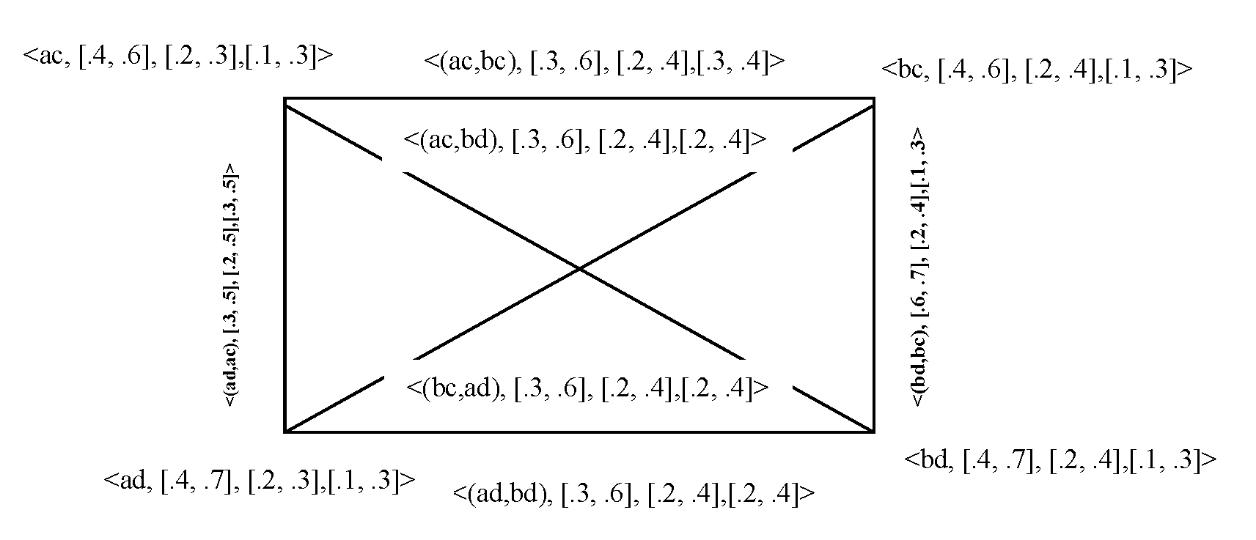
Proposition2 The composition��1[��2] =(��1 ∘��2, ��1 ∘��2) of two interval valued neutrosophic graphs of the graphs ��1 ∗and ��2 ∗ is an interval valued neutrosophic graph of ��1 ∗[��2 ∗]. Proof. Verifying only conditions for B1 ∘B2, because conditions for A1 ∘A2 are obvious. Let E= {(��,��2) (��,��2) /��1 ∈��1, ��2��2 ∈��2} ∪{(��1, ��) (��1, ��) /�� ∈��2,��1��1 ∈��1}.Considering(��,��2) (��,��2) ∈��, one has: ( ����1�� ∘����2�� ) (( �� , ��2 ) ( �� ,��2 )) = min ( ����1��(�� ), ����2��(��2��2 )) ≤ min ( ����1��(�� ), min(����2��(��2),����2��(��2)))= min(min (����1��(��),����2��(��2)), min (����1��(��),����2��(��2)))= min ((����1�� ∘����2��) (��,��2),(����1�� ∘����2��) (��,��2)), (40)
(����1�� ∘����2�� ) ((�� , ��2 ) (�� ,��2 )) = min (����1��(�� ), ����2��(��2��2 )) ≤ min (����1��(�� ), min(����2��(��2),����2��(��2)))= min(min (����1��(��),����2��(��2)), min (����1��(��),����2��(��2)))= min ((����1�� ∘����2��) (��,��2),(����1�� ∘����2��) (��,��2)), (41) ( ����1�� ∘����2�� ) (( �� , ��2 ) ( �� , ��2 )) = max ( ����1��(�� ), ����2��(��2��2 )) ≥ max ( ����1��(�� ), max(����2��(��2),����2��(��2))) = max(max (����1��(��),����2��(��2 )), max (����1��(�� ),����2��(��2 ))) = max((����1�� ∘����2��) (��,��2),(����1�� ∘����2��) (��,��2)), (42) ( ����1�� ∘����2�� ) (( �� ,��2 ) ( �� ,��2 )) = max ( ����1��(�� ), ����2��(��2��2 )) ≥ max ( ����1��(�� ), max(����2��(��2),����2��(��2))) = max(max (����1��(��),����2��(��2)), max (����1��(��),����2��(��2))) = max ((����1�� ∘����2��) (��,��2),(����1�� ∘����2��) (��,��2)), (43) (����1�� ∘����2�� ) ((�� ,��2 ) (�� ,��2 )) = max (����1��(��), ����2��(��2��2 )) ≥ max (����1��(��), max(����2��(��2),����2��(��2))) = max(max (����1��(��),����2��(��2)), max (����1��(��),����2��(��2))) = max ((����1�� ∘����2��) (��,��2),(����1�� ∘����2��) (��,��2)), (44) (����1�� ∘����2�� ) ((�� ,��2 ) (�� ,��2 )) = max (����1��(�� ), ����2��(��2��2 )) ≥ max (����1��(�� ), max(����2��(��2),����2��(��2))) = max(max (����1��(��),����2��(��2), max (����1��(��),����2��(��2)) = max((����1�� ∘����2��) (��,��2),(����1�� ∘����2��) (��,��2)). (45) In the case (��1, ��) (��1, ��)∈��, the proof is similar. In the case (��1,��2) (��1,��2) ∈��0 -E. (����1�� ∘����2��)((��1,��2) (��1,��2)) = min (����2��(��2), ����2��(��2), ����1��(��1��1))≤ min (����2��(��2), ����2��(��2 ),min (����1��(��1 ), ����1��(��1 ))) = min(min ( ����1��(��1 ), ����2��(��2 )), min (����1��(��1),����2��(��2))) = min ((����1�� ∘����2��) (��1,��2),(����1�� ∘����2��) (��1,��2)), (46) (����1�� ∘����2��) ((��1,��2) (��1,��2)) = min (����2��(��2), ����2��(��2), ����1��(��1��1)) ≤ min (����2��(��2), ����2��(��2),min (����1��(��1), ����1��(��1))) = min(min (����1��(��1),����2��(��2)), min (����1��(��1),����2��(��2))) = min ((����1�� ∘����2��) (��1,��2),(����1�� ∘����2��) (��1,��2)),(47) (����1�� ∘����2��) ((��1 ,��2) (��1 ,��2)) = max (����2��(��2), ����2��(��2), ����1��(��1��1)) ≥ max (����2��(��2), ����2��(��2 ),max (����1��(��1 ), ����1��(��1 ))) = max(max ( ����1��(��1 ), ����2��(��2 )), max (����1��(��1),����2��(��2))) = max ((����1�� ∘����2��) (��1,��2),(����1�� ∘����2��) (��1,��2)), (48) (����1�� ∘����2��) ((��1,��2) (��1,��2)) = max (����2��(��2), ����2��(��2), ����1��(��1��1))≥ max (����2��(��2), ����2��(��2 ),max (����1��(��1 ), ����1��(��1 ))) = max(max ( ����1��(�� ), ����2��(��2 )), max (����1��(��1),����2��(��2))) = max ((����1�� ∘����2��) (��1,��2),(����1�� ∘����2��) (��1,��2)), (49) (����1�� ∘����2��) ((��1 ,��2) (��1 ,��2)) = max (����2��(��2), ����2��(��2), ����1��(��1��1)) ≥ max (����2��(��2 ), ����2��(��2 ),max(����1��(��1 ), ����1��(��1))) = max(max (����1��(��),����2��(��2 )), max (����1��(��1),����2��(��2)))= max ((����1�� ∘����2��) (��1,��2),(����1�� ∘����2��) (��1,��2)), (50)
(����1�� ∘����2��) ((��1,��2) (��1,��2)) = max(����2��(��2) , ����2��(��2), ����1��(��1��1)) ≥ max (����2��(��2), ����2��(��2),max (����1��(��1), ����1��(��1))) = max(max (����1��(��),����2��(��2)), max (����1��(��1),����2��(��2))) = max ((����1�� ∘����2��) (��1,��2),(����1�� ∘����2��) (��1 ,��2)). (51)
This completes the proof. Definition 19
The union��1 ∪ ��2= (��1 ∪��2, ��1 ∪��2 ) of two interval valued neutrosophic graphs of the graphs ��1 ∗and��2 ∗is an interval-valued neutrosophic graph of ��1 ∗ ∪��2 ∗ . 1) (����1�� ∪����2��) (��) = ����1��(��) if x ∈��1 and x ∉��2, (����1�� ∪����2��) (��) = ����2��(��) if x ∉��1 and x ∈��2, (����1�� ∪����2��) (��) = max (����1��(��), ����2��(��)) if x ∈��1 ∩��2, (52) 2) (����1�� ∪����2��) (��) = ����1��(��) if x ∈��1 and x ∉��2, (����1�� ∪����2��) (��) = ����2��(��) if x ∉��1 and x ∈��2, (����1�� ∪����2��) (��) = max (����1��(��), ����2��(��)) if x ∈��1 ∩��2, (53) 3) (����1�� ∪����2��) (��) = ����1��(��) if x ∈��1 and x ∉��2, (����1�� ∪����2��) (��) = ����2��(��) if x ∉��1 and x ∈��2, (����1�� ∪����2��) (��) = min (����1��(��), ����2��(��) ) if x ∈��1 ∩��2, 4) (����1�� ∪����2��) (��) = ����1��(��) if x ∈��1 and x ∉��2, (54)
(����1�� ∪����2��) (��) = ����2��(��) if x ∉��1 and x ∈��2, (����1�� ∪����2��) (��) = min (����1��(��), ����2��(��) ) if x ∈��1 ∩��2, (55) 5) (����1�� ∪����2��) (��) = ����1��(��) if x ∈��1 and x ∉��2, (����1�� ∪����2��) (��) = ����2��(��) if x ∉��1 and x ∈��2, (����1�� ∪����2��) (��) = min (����1��(��), ����2��(��) ) if x ∈ ��1 ∩��2, (56) 6) (����1�� ∪����2��) (��) = ����1��(��) if x ∈��1 and x ∉��2, (����1�� ∪����2��) (��) = ����2��(��) if x ∉��1 and x ∈��2, (����1�� ∪����2��) (��) = min (����1��(��), ����2��(��) ) if x ∈��1 ∩��2, (57) 7) (����1�� ∪����2��) (����) = ����1��(����) if xy ∈��1and xy ∉��2, (����1�� ∪����2��) (����) = ����2��(����) if xy ∉��1 and xy ∈��2, (����1�� ∪����2��) (����) = max (����1��(����), ����2��(����) ) if xy ∈��1 ∩��2, (58) 8) (����1�� ∪����2��) (����) = ����1��(����) if xy ∈��1 and xy ∉��2, (����1�� ∪����2��) (����) = ����2��(����) if xy ∉��1 and xy ∈��2, (����1�� ∪����2��) (����) = max (����1��(����), ����2��(����) ) if xy ∈��1 ∩��2, (59) 9) (����1�� ∪����2��) (����) =����1��(����) if xy ∈��1 and xy ∉��2, (����1�� ∪����2��) (����) = ����2��(����) if xy ∉��1 and xy ∈��2,
(����1�� ∪����2��) (����) = min (����1��(����), ����2��(����) ) if xy ∈��1 ∩��2, (60) 10)(����1�� ∪����2��) (����) = ����1��(����) if xy ∈��1 and xy ∉��2, (����1�� ∪����2��) (����) = ����2��(����) if xy ∉��1 and xy ∈��2, (����1�� ∪����2��) (����) = min (����1��(����), ����2��(����) ) if xy ∈��1 ∩��2, (61) 11)(����1�� ∪����2��) (����) = ����1��(����) if xy ∈��1 and xy ∉��2, (����1�� ∪����2��) (����) = ����2��(����) if xy ∉��1 and xy ∈��2, (����1�� ∪����2��) (����) = min (����1��(����), ����2��(����) ) if xy ∈ ��1 ∩��2, (62) 12)(����1�� ∪����2��) (����) =�� ��1��(����) if xy ∈��1 and xy ∉��2, (����1�� ∪����2��) (����) = ����2��(����) if xy ∉��1 and xy ∈��2, (����1�� ∪����2��) (����) = min (����1��(����), ����2��(����) ) if xy ∈��1 ∩��2. (63)
Proposition 3
Let ��1 and ��2 are two interval valued neutrosophic graphs, then ��1 ∪��2 is an interval valued neutrosophic graph.
Proof. Verifying only conditions for B1 ∘B2, because conditions for A1 ∘A2 are obvious. Let x y ∈��1 ∩��2. Then: ( TB1L ∪TB2L )( xy ) = max( TB1L(xy ), TB2L(xy )) ≤ max(min( TA1L(x ), TA1L(y )), min( TA2L(x ), TA2L(y ))) = min(max( TA1L(x ), TA2L(x )), max( TA1L(y ), TA2L(y ))) = min((����1�� ∪����2��) (��), (����1�� ∪����2��) (��))); (64) ( TB1U ∪TB2U )( xy ) = max( TB1U(xy ), TB2U(xy )) ≤ max(min( TA1U(x ), TA1U(y )), min( TA2U(x ), TA2U(y ))) = min(max( TA1U(x ), TA2U(x )), max( TA1U(y ), TA2U(y ))) = min((����1�� ∪����2��) (��), (����1�� ∪����2��) (��))); (65) ( IB1L ∪IB2L )( xy ) = min( IB1L(xy ), IB2L(xy )) ≥ min(max( IA1L(x ), IA1L(y )), max(IA2L(x),IA2L(y))) = min(min(IA1L(x),IA2L(x)), min(IA1L(y),IA2L(y))) = max((����1�� ∪ ����2��) (��), (����1�� ∪����2��) (��))); (66) ( IB1U ∪IB2U )( xy ) = min( IB1U(xy ), IB2U(xy )) ≥ min(max( IA1U(x ), IA1U(y )), max(IA2U(x),IA2U(y))) = max(min(IA1U(x),IA2U(x)), min(IA1U(y),IA2U(y))) = max((����1�� ∪ ����2��) (��), (����1�� ∪����2��) (��))); (67) ( FB1L ∪FB2L )( xy ) = min( FB1L(xy ), FB2L(xy )) ≥ min(max( FA1L(x ), FA1L(y )), max( FA2L(x ), FA2L(y ))) = min(min( FA1L(x ), FA2L(x )), min( FA1L(y ), FA2L(y ))) = max((����1�� ∪����2��) (��), (����1�� ∪����2��) (��))); (68) ( FB1U ∪FB2U )( xy ) = min( FB1U(xy ), FB2U(xy )) ≥ min(max( FA1U(x ), FA1U(y )), max( FA2U(x ), FA2U(y ))) = max(min( FA1U(x ), FA2U(x )), min( FA1U(y ), FA2U(y ))) = max((����1�� ∪����2��) (��), (����1�� ∪����2��) (��))). (69)
This completes the proof. Example 5
Let ��1 ∗= (��1, ��1) and ��2 ∗= (��2, ��2) be two graphs such that ��1 ={��1,��2,��3,��4, ��5}.��2 ={��1,��2,��3,��4},��1 ={��1��2, ��1��5, ��2��3, ��5��3, ��5��4,��4��3} and ��2 ={��1��2, ��2��3, ��2��4, ��3��34, ��4��1}. Consider two interval valued neutrosophic graphs ��1= (��1, ��1) and ��2= (��2, ��2).
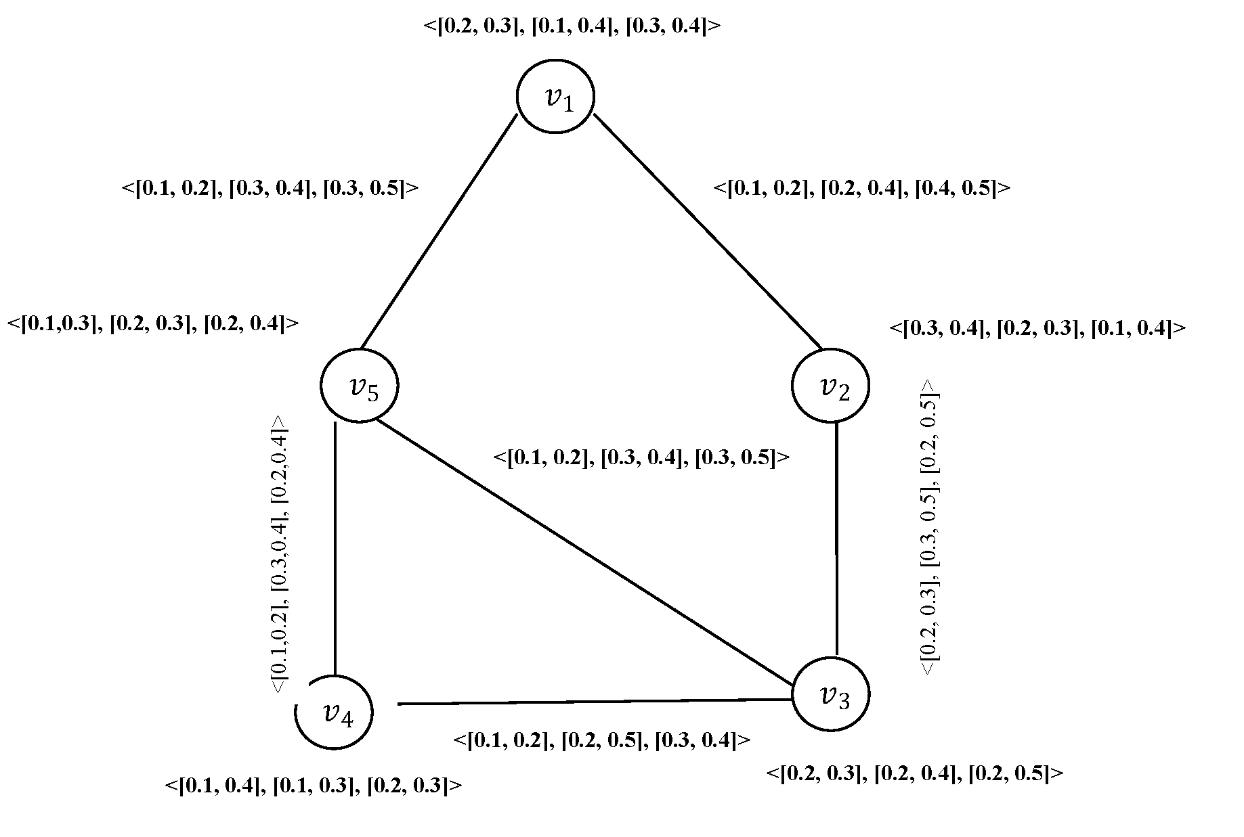
Figure 13: Interval valued neutrosophic graph G1
Figure 14: Interval valued neutrosophic graph G1
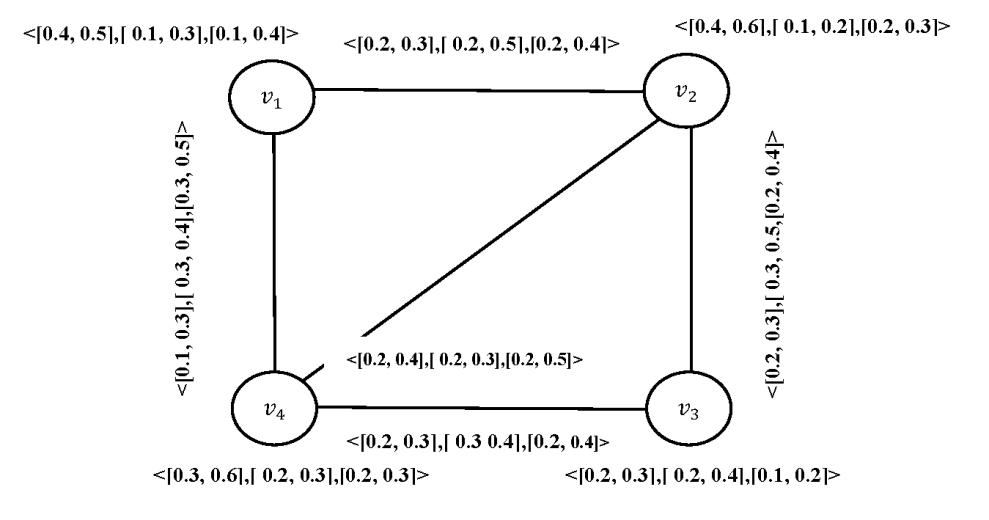
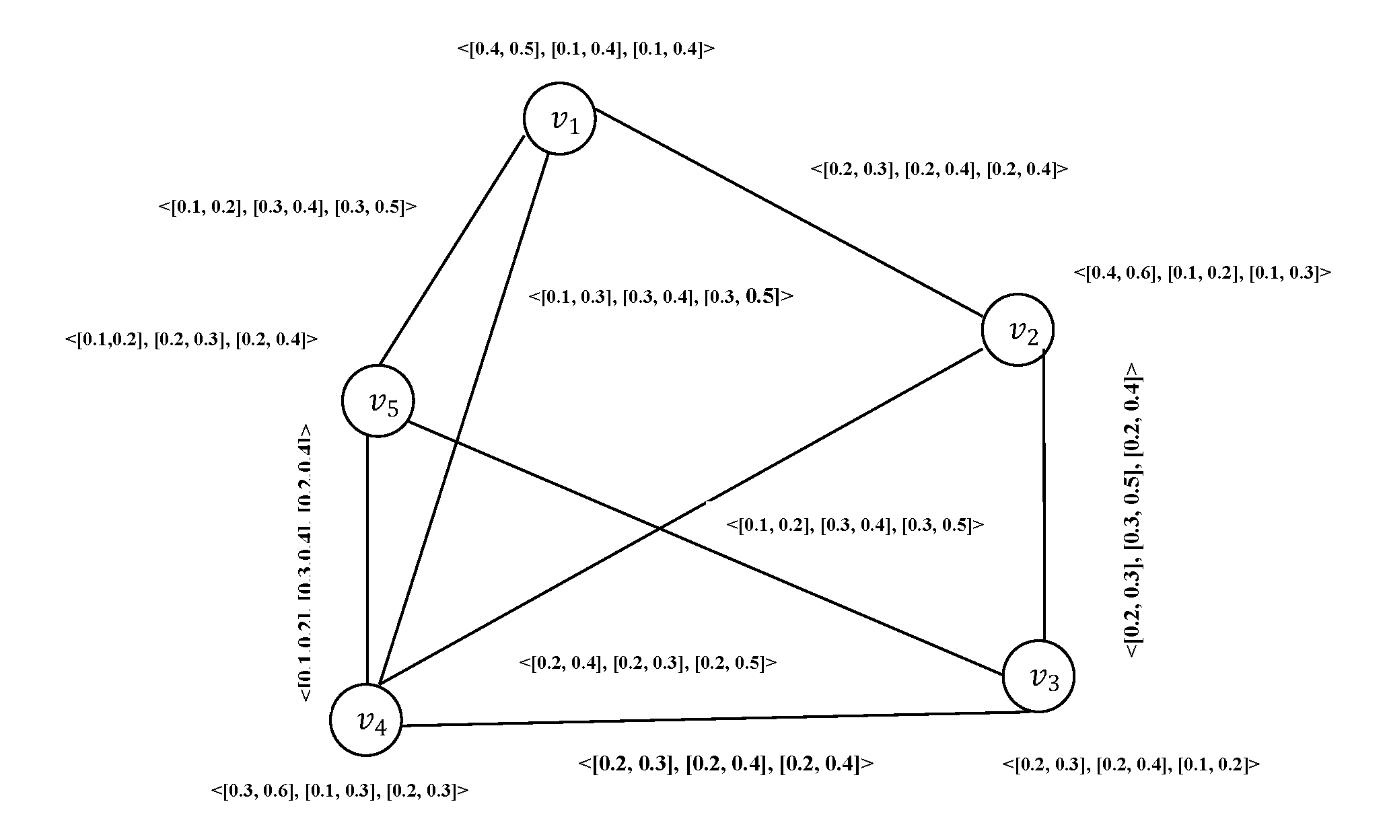
Definition 20
The join of ��1 + ��2 = (��1 +��2 , ��1 +��2 ) interval valued neutrosophic graphs ��1 and G2ofthegraphs��1 ∗and��2 ∗ is defined as follows:
1) (����1�� +����2��)(��) ={
(����1�� +����2��) (��y)={
(����1�� ∩����2��)(xy) if����∈��1 ∪��2 ����1��(����) if����∈��1 ����2��(����) if����∈��2 (����1�� +����2��) (�� y) = {(����1�� ∩����2��)(xy) if����∈��1 ∪��2 ����1��(����) if����∈��1 ����2��(����) if����∈��2 (71)
3) (����1�� +����2��) (�� y) = min (����1��(��),����2��(��)) (����1�� +����2��) (��y) = min (����1��(��),����2��(��)) (����1�� +����2��) (��y)=max (����1��(��),����2��(��)) (����1�� +����2��) (�� y) = max (����1��(��),����2��(��) (����1�� +����2��) (��y)=max (����1��(��),����2��(��)) (����1�� +����2��) (�� y) = max (����1��(��),����2��(��))�������� ∈ ��′ , where ��′ is the set of all edges joining the nodes of ��1 and ��2, assuming��1 ∩��2=∅. (72)
Example 6
Let ��1 ∗= (��1, ��1) and ��2 ∗= (��2, ��2) be two graphs such that ��1 ={��1,��2,��3},��2 ={��1,��2,��3},��1 ={��1��2, ��2��3} and ��2 ={��1��2, ��2��3}. Consider two interval valued neutrosophic graphs ��1= (��1, ��1) and ��2= (��2, ��2).
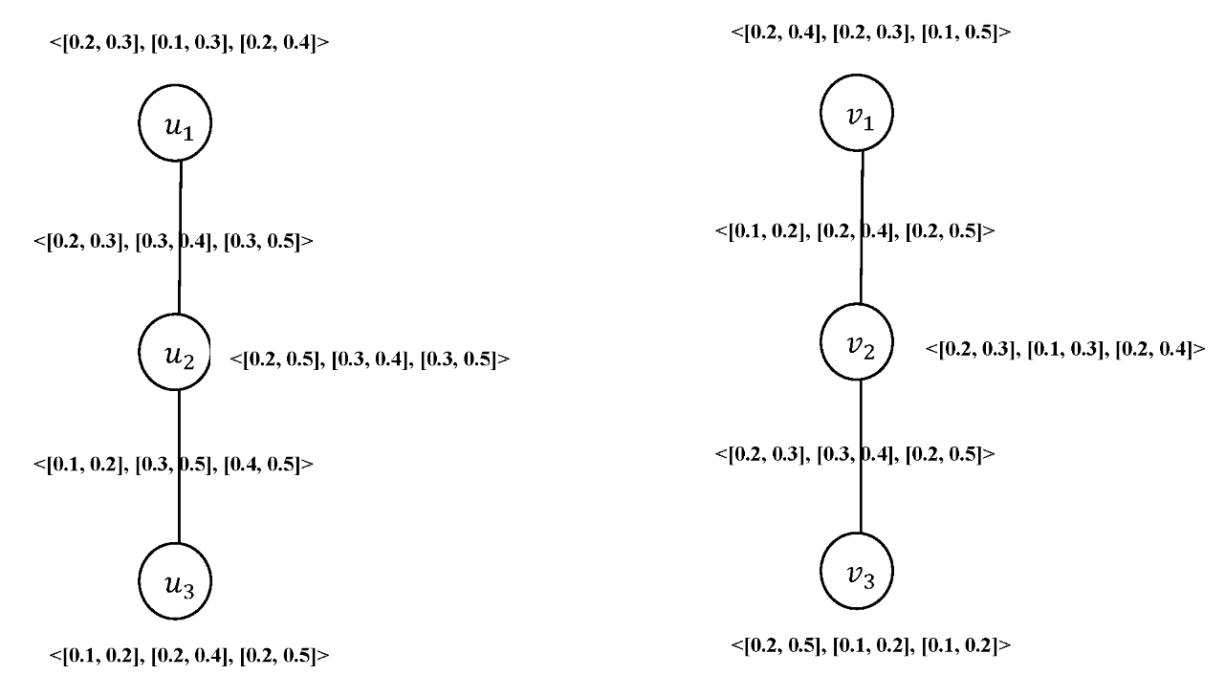
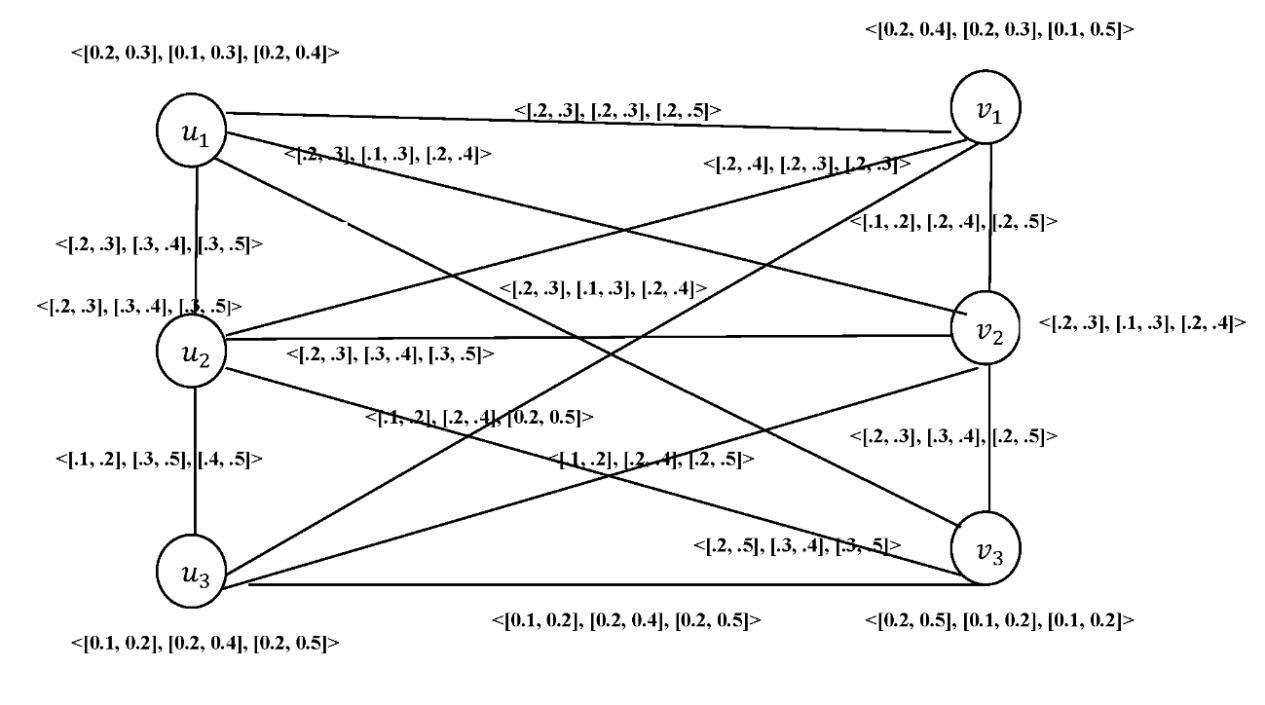
5. Conclusion
The interval valued neutrosophic models give more precision, flexibility and compatibility to the system as compared to the classical, fuzzy, intuitionistic fuzzy and neutrosophic models. In this paper, the authors introduced some operations: Cartesian product, composition, union and join on interval valued neutrosophic graphs, and investigated some of their properties. In the future, the authors plan to study others operations, such as: tensor product and normal product of two interval valued neutrosophic graphs.
References
1. Ansari, A. Q., Biswas,R., &Aggarwal S.(2013a).Neutrosophic classifier: An extension of fuzzy classifier. Elsevier, Applied Soft Computing, 13, 563-573, http://dx.doi.org/10.1016/ j.asoc.2012.08.002. 2. Ansari, A. Q., Biswas,R., &Aggarwal, S.(2013b). (Presentation) Neutrosophication of Fuzzy Models, In: Proceedings of the IEEE Workshop On Computational Intelligence: Theories, Applications and Future Directions (hostedby IIT Kanpur), IEEE, 14th July 2013. 3. Ansari, A. Q., Biswas,R.,&Aggarwal, S. (2013c).Extension to fuzzy logic representation: Moving towards neutrosophic logic - A new laboratory rat. In: Proceedings of the IEEE Workshop On Fuzzy Systems (FUZZ), IEEE: 1 –8.DOI:10.1109/FUZZ-IEEE.2013.6622412. 4. Atanassov, K. (1999).Intuitionistic fuzzy sets: theory and applications, Physica, New York. 5. Atanassov, K. (1986). Intuitionistic fuzzy sets, Fuzzy Sets and Systems, vol. 20: 87-96. 6. Atanassov, K., Gargov, G. (1989). Interval valued intuitionistic fuzzy sets, Fuzzy Sets and Systems, vol.31:343-349. 7. Antonios, K., Stefanos, S., Lazaros, I., &Elias, P. (2014).Fuzzy graphs: algebraic structure and syntactic recognition, Artificial Intelligence Review, vol 42, Issue 3:479-490. 8. Aggarwal, S., Biswas, R., &Ansari, A. Q.(2010). Neutrosophic modeling and control, Computer and Communication Technology (ICCCT), International Conference:718–723 DOI:10.1109/ICCCT.2010.5640435. 9. Broumi, S., Talea, M.,& Smarandache, F. (2016a) Single Valued Neutrosophic Graphs: Degree, Order and Size. IEEE World Congress on Computational Intelligence, 8 pages, accepted 10. Broumi, S., Talea, M., Bakali, A. and Smarandache, F. (2016b). Single Valued Neutrosophic Graphs, Journal of New Theory, N 10:86-101. 11. Broumi, S., Talea, M., Bakali, A and Smarandache, F. Interval Valued Neutrosophic Graphs. In press. 12. Broumi, S., Talea, M., Bakali, A., &Smarandache, F. (2016c). On Bipolar Single Valued Neutrosophic Graphs, Journal of New Theory, no. 11: 84-102. 13. Broumi, S., Smarandache, F., Talea, M. & Bakali, A. (2016). An Introduction to Bipolar Single Valued Neutrosophic Graph Theory. Applied Mechanics and Materials, vol.841:184-191, doi:10.4028/www.scienti_c.net/AMM.841.184 14. Broumi, S., Smarandache, F. (2014). New distance and similarity measures of interval neutrosophic sets.Information Fusion (FUSION), IEEE 17th International Conference:1 – 7. 15. Bhattacharya, P. (1987). Some remarks on fuzzy graphs, Pattern Recognition Letters, 6: 297-302. 16. Deli, I., Mumtaz, A. &Smarandache, F.(2015).Bipolar neutrosophic sets and their application based on multi-criteria decision making problems, Advanced Mechatronic Systems (ICAMechS), 2015 International Conference:249 – 254, DOI: 10.1109/ICAMechS.2015.7287068. 17. Garg, G., Bhutani, K., Kumar,M., & Aggarwal, S. (2015).Hybrid model for medical diagnosis using Neutrosophic Cognitive Maps with Genetic Algorithms, FUZZ-IEEE 2015 (IEEE International conference on fuzzy systems). 18. Hai-Long, Y., She, G., Yanhonge, & Xiuwu, L. (2015). On single valued neutrosophic relations, Journal of Intelligent & Fuzzy Systems:1-12. 19. Liu, P., &Shi, L. (2015).The generalized hybrid weighted average operator based on interval neutrosophic hesitant set and its application to multiple attribute decision making, Neural Computing and Applications, 26 (2):457-471. 20. Mishra S. N. &Pal, A. (2013). Product of Interval Valued Intuitionistic fuzzy graph, Annals of Pure and Applied Mathematics, Vol. 5, No.1:37-46. 21. Nagoor, G.A., & Shajitha Begum, S. (2010). Degree, Order and Size in Intuitionistic Fuzzy Graphs, International Journal of Algorithms, Computing and Mathematics, (3)3:11-16. 22. Nagoor, G.A., & Latha, S.R. (2012). On Irregular Fuzzy Graphs. Applied Mathematical Sciences, Vol.6, no.11:517-523.
23. Nagoor, G. A., & Basheer Ahamed, M. (2003). Order and Size in Fuzzy Graphs, Bulletin of Pure and Applied Sciences, Vol 22E (No.1):145-148. 24. Parvathi, R., Karunambigai, M. G. (2006).Intuitionistic Fuzzy Graphs. Computational Intelligence, Theory and applications, International Conference in Germany,18 -20. 25. Shannon, A., & Atanassov, K. (1994). A first step of the intuitionistic fuzzy graph, Proceeding of the first Workshop on fuzzy based Expert Systems, Sofia, sept. 28-30: 59-61. 26. Şahin, R. (2015). Cross-entropy measure on interval neutrosophic sets and its applications in multicriteria decision making, Neural Computing and Applications:1-11. 27. Smarandache, F. (2015a).Symbolic Neutrosophic Theory, Brussels, Belgium: Europanova, 195p. 28. Smarandache, F. (2015b). Refined Literal Indeterminacy and the Multiplication Law of SubIndeterminacies, Neutrosophic Sets and Systems, Vol. 9:58-63. 29. Smarandache, F. (2015c). Types of Neutrosophic Graphs and Neutrosophic Algebraic Structures together with their Applications in Technology. Seminar, Universitatea Transilvania din Brasov, Facultatea de Design de Produs si Mediu, Brasov, Romania. 30. Smarandache, F. (2006). Neutrosophic set - a generalization of the intuitionistic fuzzy set.Granular Computing, 2006 IEEE International Conference:38–42. DOI: 10.1109/GRC.2006.1635754. 31. Smarandache, F. (2011). A geometric interpretation of the neutrosophic set - A generalization of the intuitionistic fuzzy set.Granular Computing (GrC), 2011 IEEE International Conference: 602 – 606. 32. Turksen, I. (1986). Interval valued fuzzy sets based on normal forms.Fuzzy Sets and Systems, vol. 20:191-210. 33. Vasantha Kandasamy, W. B., Smarandache, F.(2013).Fuzzy Cognitive Maps and Neutrosophic Cognitive Maps, Kindle Edition. 34. Vasantha Kandasamy, W. B., Ilanthenral. K and Smarandache, F.(2015).Neutrosophic Graphs: A New Dimension to Graph Theory. Kindle Edition. 35. Vasantha Kandasamy, W.B., Smarandache,F. (2004). Analysis of social aspects of migrant laborers living with HIV/AIDS using Fuzzy Theory and Neutrosophic Cognitive Maps, Phoenix, AZ, USA: Xiquan. 36. Wang, H., Zhang, Y., & Sunderraman, R. (2005a).Truth-value based interval neutrosophic sets. Granular Computing, 2005 IEEE International Conference, Vol.1:274–277. DOI: 10.1109/GRC.2005.1547284. 37. Wang, H., Smarandache, F., Zhang,Y., &Sunderraman,R.(2010). Single valued Neutrosophic Sets, Multispace and Multistructure, 4:410-413. 38. Wang, H., Smarandache, F., Zhang,Y.Q and Sunderraman, R. (2005b).Interval Neutrosophic Sets and Logic: Theory and Applications in Computing. Phoenix, AZ, USA: Hexis. 39. Ye, J. (2014a). Some aggregation operators of interval neutrosophic linguistic numbers for multiple attribute decision making, Journal of Intelligent & Fuzzy Systems (27):2231-2241. 40. Ye, J. (2014b). Vector similarity measures of simplified neutrosophic sets and their application in multicriteria decision making, International Journal of Fuzzy Systems. Vol. 16, No. 2: 204-211. 41. Ye, J. (2014c). Similarity measures between interval neutrosophic sets and their applications in Multicriteria decision-making. Journal of Intelligent and Fuzzy Systems, 26:165-172. 42. Zimmermann, H.J. (1985). Fuzzy Set Theory and its Applications. Boston, MA, USA: Kluwer-Nijhoff. 43. Zhang, H., Wang J, Chen, X. (2015a). An outranking approach for multi-criteria decision-making problems with interval-valued neutrosophic sets. Neural Computing and Applications, 1-13. 44. Zhang, H.Y., Ji, P., Wang, Q.J, Chen, H. X.(2015b). An Improved Weighted Correlation Coefficient Based on Integrated Weight for Interval Neutrosophic Sets and its Application in Multi-Criteria Decisionmaking Problems, International Journal of Computational Intelligence Systems, vol 8, Issue 6. 45. Zhang, H.Y., Wang, J.Q. & Chen, X.H. (2014). Interval neutrosophic sets and their application in multicriteria decision making problems. The Scientific World Journal,DOI:10.1155/2014/ 645953. 46. Zadeh, L. (1965).Fuzzy sets, Information and Control, 8:338-353.


